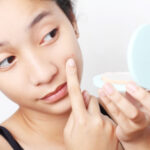 Acne is caused by clogged pores (also called hair follicles), which are small openings in the skin through which hair grows. Deep inside each follicle is a hair shaft attached to small glands called “sebaceous glands.” These glands make an oily substance called “sebum” to moisten our hair and skin. When too much sebum is made, it can mix with dead skin cells (that we are constantly shedding) to create a sticky plug, which clogs the hair follicle. Your back and chest also have many sebaceous glands so that’s why some people get acne in these areas. There are effective treatments for acne that may include medication for severe breakouts. There are also things to avoid such as greasy lotions and avoiding squeezing or picking your skin. Read more about acne here.
Acne is caused by clogged pores (also called hair follicles), which are small openings in the skin through which hair grows. Deep inside each follicle is a hair shaft attached to small glands called “sebaceous glands.” These glands make an oily substance called “sebum” to moisten our hair and skin. When too much sebum is made, it can mix with dead skin cells (that we are constantly shedding) to create a sticky plug, which clogs the hair follicle. Your back and chest also have many sebaceous glands so that’s why some people get acne in these areas. There are effective treatments for acne that may include medication for severe breakouts. There are also things to avoid such as greasy lotions and avoiding squeezing or picking your skin. Read more about acne here.
Our health guides are developed through a systematic, rigorous process to ensure accuracy, reliability, and trustworthiness. Written and reviewed by experienced healthcare clinicians from Boston Children's Hospital, a Harvard Medical School teaching hospital and consistently ranked as a top hospital by Newsweek and U.S. News & World Report, these guides combine clinical expertise, specialized knowledge, and evidence-based medicine. We also incorporate research and best practices from authoritative sources such as the CDC, NIH, PubMed, top medical journals, and UpToDate.com. Clinical specialists and subject matter experts review and edit each guide, reinforcing our commitment to high-quality, factual, scientifically accurate health information for young people.